|
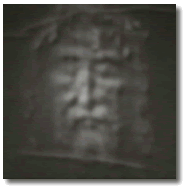
Home
The
Face
The Image
The
Body
The History
The Evidence
The Science
The Gospels
The Church
The Exhibit
The Links
Calender
About Us
Contact
Us
|
|
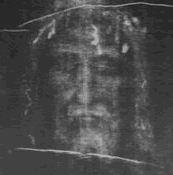
Many
scientist have used knowledge of forensic medicine to determine the
characteristics and cause of death of the man of the Shroud. Here,
we show some of the data published in "The
Authentication of the Turin Shroud: An Issue in Archaeological
Epistemology by William Meacham. Current Antropology- Vol. 24 - N° 3
- (June 1983). Published by the University of Chicago Press".
Although there is no general agreement among the
scholars about all the details presented in this article, we think
it is a good guide to approach the issue.
The autopsy:
"The
body was that of an adult male, nude, with beard, mustache, and long
hair falling to the shoulders and drawn at the back into a pigtail
(today there are serious doubts about this
last assertion). Height is estimated at between 5 ft. 9
in. and 5 ft. 11 in. (175-180 cm), weight at 165-180 lb. (75-81 kg),
and age at 30 to 45 years. The body is well proportioned and
muscular, with no observable defects. Death had occurred several
hours before the deposition of the corpse, which was laid out on
half of the Shroud, the other half then being drawn over the head to
cover the body. It is clear that the cloth was in contact with the
body for at least a few hours, but not more than two to three days,
assuming that decomposition was progressing at the normal rate. Both
frontal and dorsal images have the marks of many small drops of a
postmortem serous fluid exuded from the pores. There is, however, no
evidence of initial decomposition of the body, no issue of fluids
from the orifices, and no decline of rigor mortis leading to
flattening of the back and blurred or double imprints.
Rigor mortis is seen in the stiffness of the
extremities, the retraction of the thumbs (discussed below), and the
distention of the feet. It has frozen an attitude of death while
hanging by the arms; the rib cage is abnormally expanded, the large
pectoral muscles are in an attitude of extreme inspiration (enlarged
and drawn up toward the collarbone and arms), the lower abdomen is
distended, and the epigastric hollow is drawn in sharply. The
protrusion of the femoral quadriceps and hip muscles is consistent
with slow death by hanging, during which the victim must raise his
body by exertion of the legs in order to exhale.
|
|
|
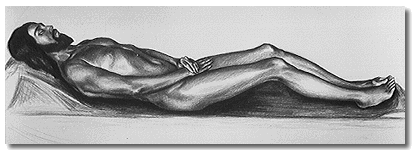 |
|
Position of the body according to Isabel Piczek
|
|
The evidence of death in a position of suspension by
the arms coupled with the characteristic wounds and blood flows indicate
that the individual had been crucified. The rigor mortis position of
outstretched arms would have had to be broken in order to cross the
hands at the pelvis for burial, and a probable result is seen in the
slight dislocation of the right elbow and shoulder. The feet indicate
something of their original positioning on the cross, the left being
placed on the instep of the right with a single nail impaling both.
Apparently there was some flexion of the left knee to achieve this
position, leaving the left foot somewhat higher than the right. Two
theories, each supported by experimental or wartime observations,
contend as regards to cause of death: asphyxiation due to muscular
spasm, progressive rigidity, and inability to exhale (Barbet, Hynek,
Bucklin) or circulatory failure from lowering of blood pressure and
pooling of blood in the lower extremities (Moedder, Willis).
Of greatest interest and importance are the wounds. As
with the general anatomy of the image, the wounds, blood flows, and the
stains themselves appear to forensic pathologists flawless and
unfakeable. "Each of the different wounds acted in a characteristic
fashion. Each bled in a manner which corresponded to the nature of the
injury. The blood followed gravity in every instance" (Bucklin 1961:5).
The bloodstains are perfect, bordered pictures of blood clots, with a
concentration of red corpuscles around the edge of the clot and a tiny
area of serum inside.
Around the upper scalp and extending to its vertex are
at least 30 blood flows from spike punctures. These wounds exhibit the
same realism as those of the hand and feet: the bleeding is highly
characteristic of scalp wounds with the retraction of torn vessels, the
blood meets obstructions as it flows and pools on the forehead and hair,
and there appears to be swelling around the points of laceration.
Several clots have the distinctive characteristics of either venous or
arterial blood, as seen in the density, uniformity, or modality of
coagulation (Rodante). |
|
|
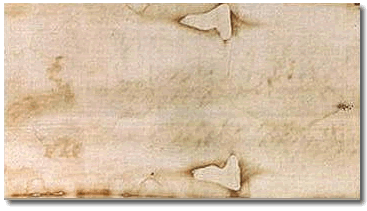 |
|
|
|
Legs and right foot |
Posterior part of the
head and front
|
|
| |
| The
body is peppered with marks of a severe flogging estimated at between 60
and 120 lashes of a whip with two or three studs at the thong end. Each
contusion is about 3.7 cm long, and these are found on both sides of the
body from the shoulders to the calves, with only the arms spared.
|
|
|
|
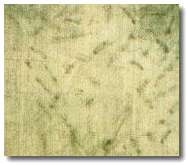 |
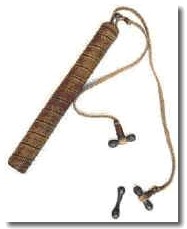 |
|
Detail of the marks in
the back. These wounds have the exact size and form of those that
would be produced by the Flagrum taxillatum, a roman whip not
used in the Middle Ages.
|
|
|
Superimposed on the marks of flogging on the right
shoulder and left scapular region are two broad excoriated areas,
generally considered to have resulted from friction or pressure from a
flat surface, as from carrying the crossbar or writhing on the cross.
The
wounds of the crucifixion itself are seen in the blood flows from the
wrists and feet. One of the most interesting features of the Shroud is
that the nail wounds are in the wrists, not in the palm as
traditionally depicted in art. Experimenting with cadavers and
amputated arms, Barbet demonstrated that nailing at the point
indicated on the Shroud image, the so-called space of Destot between
the bones of the wrist, allowed the body weight to be supported,
where-as the palm would tear away from the nail under a fraction of
the body weight. Sava holds that the wrist bones and tendons would be
severely damaged by nailing and that the Shroud figure was nailed
through the wrist end of the forearm, but most medical opinion concurs
in positing the nailing at the wrist. Barbet also observed that the
median nerve was invariably injured by the nail, causing the thumb to
retract into the palm. Neither thumb is visible on the Shroud, their
position in the palm presumably being retained by rigor mortis.
(There are many opinions about this issue, certainly we see the
exit wound of the nail around the wrist area but we do not know where
the entry wound is located) |
|
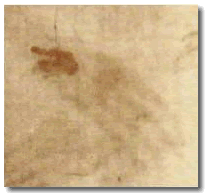 |
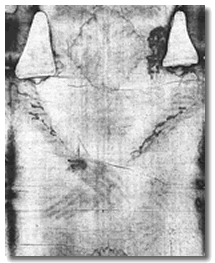 |
|
Detail of wound in left
hand and blood in the arms
|
|
|
The
blood flow from the wrists trails down the forearms at two angles,
roughly 55° and 65° from the axis of the arm, thus allowing the
crucifixion position of the arms to be reconstructed. It is
generally agreed that the separate flows from the left wrist and the
interrupted streams along the length of the arm are due to slightly
different positions assumed by the body on the cross. This seesaw
motion is interpreted as necessary simply in order to breathe or as
an attempt to relieve the pain in the wrists (the median nerve is
also sensory and pain from injuries to it is excruciating). A
postmortem blood flow with separation of serum is seen around the
left wrist and more copiously at the feet, presumably from the
removal of the nails.
(There is a more
simple explanation accounting for this blood flow: the flow by
gravity of postmortem blood once the body was laid down and the
hands were crossed over the pelvis).
|
|
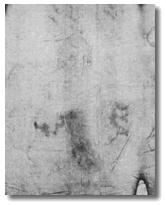 |
|
Right foot
|
|
|
Between
the fifth and sixth ribs on the right side is an oval puncture about
4.4 X 1.1 cm. Blood has flowed down from this wound and also onto
the lower back, indicating a second outflow when the body was moved
to a horizontal position. All authorities agree that this wound was
inflicted after death, judging from the small quantity of blood
issued, the separation of clot and serum, the lack of swelling, and
the deeper color and more viscous consistency of the blood. Stains
of a body fluid are intermingled with the blood, and numerous
theories have been offered as to its origin: pericardial fluid (Judica,
Barbet), fluid from the pleural sac (Moedder), or serous fluid from
settled blood in the pleural cavity (Saval, Bucklin).
|
|
 |
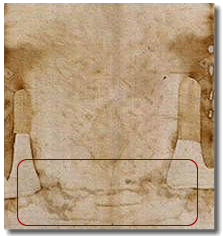 |
|
Side wound (curiously
with the same dimensions of a roman lancet) and dorsal part of
the body where the second outflow generated as the body was moved to a
horizontal position can be seen.
|
|
|
|
Also
discernible are a number of facial wounds, listed by Willis as
swelling of both eyebrows, torn right eyelid, large swelling below
right eye, swollen nose, bruise on right cheek, swelling in left cheek
and left side of chin.
Some of these details
can be seen in
THE FACE.
|
|
So convincing was the realism of these wounds and their
association with the biblical accounts that Delage, an agnostic,
declared them "a bundle of imposing probabilities" and concluded that
the Shroud figure was indeed Christ. His assistant, Vignon (1937),
declared the Shroud's identification to be "as sure as a photograph or
set of fingerprints."
Taking
into account all these data and even considering that different opinions
exist among scholars about particular details, it is not difficult to
draw the following conclusion: The Shroud of Turin wrapped a
real man that was tortured and suffered death by crucifixion.
There
is no other explanation.
Of the same opinion were Pierre Barbet (surgeon at
Hospital of Paris), Giovanni Judica Cordiglia (Professor of Legal
Medicine at the University of Milan), Robert Bucklin (Pathologist, Los
Angeles Hospital, California), Rudolf W. Hynek (Medicine Academy of
Prague) and Pier Luigi Baima Bollone (Professor of Legal Medicine at the
University of Turin).
No
artist could have reproduced all these details in the Middle Ages, when
it was unknown, for example, the existence of two types of blood, the
accumulation of bilirubin in tortured bodies or the details about blood
circulation.
On the
other hand, it seems improbable that somebody could have produced in
that time the very unpopular image of a Jesus naked and with wounds in
the wrists instead of in the hands as the image of the crucified Christ
has been traditionally depicted. |
|
|
|
